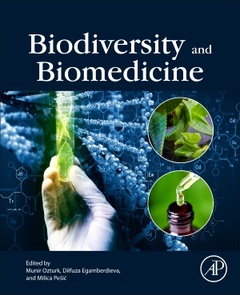Description
Biodiversity and Biomedicine
Our Future
Coordinators: Ozturk Munir, Egamberdieva Dilfuza, Pešić Milica
Language: English
Subject for Biodiversity and Biomedicine:
608 p. · 21.4x27.6 cm · Paperback
Description
/li>Contents
/li>Readership
/li>Biography
/li>Comment
/li>
Biodiversity and Biomedicine: Our Future provides a new outlook on Earth?s animal, plant, and fungi species as vital sources for human health treatments. While there are over 10 million various species on the planet, only 2 million have been discovered and named. This book identifies modern ways to incorporate Earth?s species into biomedical practices and emphasizes the need for biodiversity conservation.
Written by leading biodiversity and biomedical experts, the book begins with new insights on the benefits of biologically active compounds found in fungi and plants, including a chapter on the use of wild fruits as a treatment option. The book goes on to discuss the roles of animals, such as amphibians and reptiles, and how the threatened presence of these species must be reversed to conserve biodiversity. It also discusses marine organisms, including plants, animals, and microbes, as essential in contributing to human health.
Biodiversity and Biomedicine: Our Future is a vital source for researchers and practitioners specializing in biodiversity and conservation studies. Students in natural medicine and biological conservation will also find this useful to learn of the world?s most bio-rich communities and the molecular diversity of various species.
1. Plant microbiome: source for biological active compounds 2. Chemodiversity in natural plant populations as a base for biodiversity conservation 3. Harnessing the Potential of Plant Biodiversity in Health and Medicine: Opportunities and Challenges 4. Biomining Fungal Endophytes from Tropical Plants and Seaweeds for Drug Discovery 5. Biomedicine developments based on marine biodiversity: Present and Future 6. Superbugs, Silver bullets and new Battlefields 7. The benefits of active substances in amphibians and reptiles and the jeopardy of losing those species forever 8. Human genetic diversity in health and disease 9. Potential for cancer treatment: natural products from The Balkans 10. Biodiversity of wild fruits with medicinal potential in Serbia 11. Some Botanicals from the Himalayas with Anticancer Potential 12. Diversity and bioprospect significance of macrofungi in the scrub jungles of southwest India 13. Mushroom and plant extracts as potential intervening supplements in diabetes management 14. Anticancer activities of marine macroalgae: status and future perspectives 15. Insights into the Bioactive Compounds of Endophytic Fungi in Mangroves 16. Essentiality of Mint: Current Understanding and Future Prospects 17. Azadirachta indica: The Medicinal Properties of The Global Problems Solving Tree 18. Advancements in plant transgenomics approach for the biopharmaceutics and vaccines production 19. Secondary Metabolites from Endangered Gentiana, Gentianella, Centaurium, and Swertia species (Gentianaceae): Promising Natural Biotherapeutics 20. Grape (Vitis vinifera L.): health benefits and effects of growing conditions on quality parameters 21. Flavonoids in Cancer Therapy: Current and Future Trends 22. Personalized Biomedicine in Cancer: From Traditional Therapy to Sustainable Healthcare 23. Tumor-Specific Genetic Profiling and Therapy in Biomedicine 24. Vascular and bone marrow explant models to assess in-vitro haematotoxicity of herbal extracts. 25. Nature-inspired synthetic analogues of quorum sensing signaling molecules as novel therapeutics against Pseudomonas aeruginosa infections 26. Commodification of Biodiversity: Promises and Pitfalls
Researchers and practitioners in biodiversity, conservation studies, and natural biomedicine
Dilfuza Egamberdieva is a research associate at the Centre of Agricultural Landscape Research, Germany and head of Joint Uzbek-China Key Lab of Ecobiomes of Arid Lands, National University of Uzbekistan. Her research interests include microbial ecology and diversity, plant-microbe interaction, plant nutrition and stress tolerance, and plant biological disease control. She has been awarded the SCOPUS-2019 Award “Top Scientist of the Year, TWAS (The World Academy of Science) Award in Agricultural Sciences (2013), and TWAS-TWOWS-SCOPUS Young Women Research Award (2009), as well as several Fellowships such as President’s International Fellowship for Visiting Professors (PIFI), The Chinese Academy of Sciences (CAS), and the Georg Forster Research Fellowships, Alexander von Humboldt Foundation. She is a member of several journals’ editorial board, authored seven books published by Elsevier and Springer,
- Presents new developments in documenting and identifying species for biodiversity conservation and ethical considerations for biodiversity research
- Examines biodiversity as an irreplaceable resource for biomedical breakthroughs using available species for medical research
- Discusses challenges and opportunities for biodiversity protection and research in biosphere reserves
These books may interest you

Alpine Biodiversity in Europe 210.99 €



